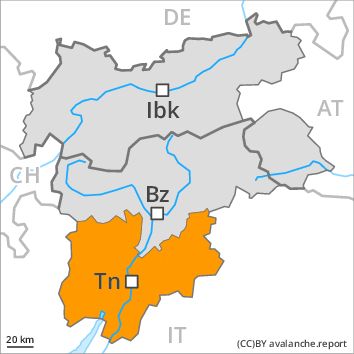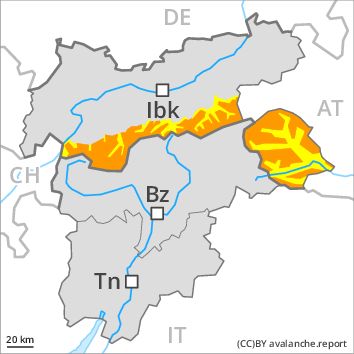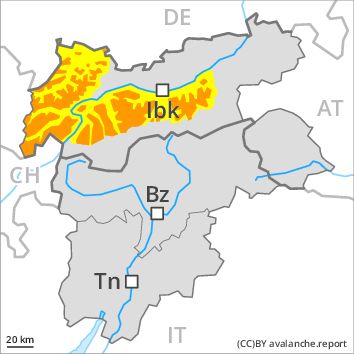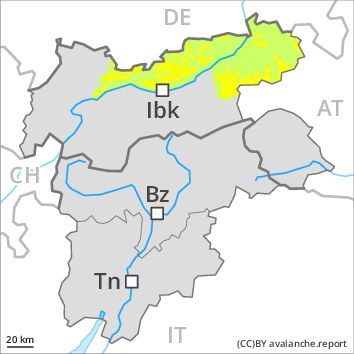Regions
Sexten Dolomites, Eastern Pfunderer Mountains, Durreck Range, Val Müstair Alps, Western Rieserferner Mountains, Langtaufers, Western Deferegger Alps, Schnals Ridge, Ortler Range, Southern Stubai Alps, Ulten Valley, Southern Zillertal Alps and High Tauern, Eastern Nonsberger Alps, Saldurn-Mastaun Ridge, Northern Dolomites of Fiemme, Texel Mountains, Gröden Dolomites, Sarntal Alps, Prags Dolomites, Western Pfunderer Mountains

Danger level
Danger Level 3 - Considerable
Avalanche Problem
Gliding snow above 2400m, N-NE-E-SE-S-SW-W-NW
New snow, N-NE-E-SE-S-SW-W-NW

The snow sport conditions outside marked and open pistes are dangerous.
As the precipitation becomes more intense dry and wet avalanches are possible during the night, in particular medium-sized ones, in the regions exposed to heavier precipitation in particular on wind-loaded slopes and. Especially below approximately 2400 m small and medium-sized gliding avalanches are to be expected. From high-altitude starting zones in the regions exposed to precipitation the avalanches can in isolated cases reach fairly large size and in some places endanger transportation routes that are exposed. Single winter sport participants can release avalanches very easily. Ski touring and other off-piste activities, including snowshoe hiking, call for extensive experience in the assessment of avalanche danger and careful route selection.
Snowpack
As a consequence of fresh snow and a strong to storm force southwesterly wind, extensive wind slabs formed in the last few days also in areas not adjacent to ridgelines. 20 to 40 cm of snow, and up to 50 cm in some localities, will fall in the next few hours above approximately 1700 m. By the middle of the day the wind slabs will increase in size additionally. Faceted weak layers exist in the old snowpack in particular adjacent to ridgelines. The old snowpack will be moist below approximately 2200 m.
Tendency
Once the snowfall has ended, the natural avalanche activity will appreciably decrease. There is a danger of gliding avalanches, especially in the regions with a lot of snow in particular below approximately 2200 m.
Regions
Latemar, Southern Adamello, Primiero - Pale di S. Martino, Adamello - Presanella, Prealps, Northern Brenta - Peller, Cembra Valley, Bondone and Stivo, Vallarsa, Western Nonsberg Alps, Folgaria - Laverone, Southern Brenta, Fassa Valley, Sole, Pejo and Rabbi, Southern Lagorai, Ledro Valley, Northern Lagorai, Maddalene, Paganella, Marzola - Valsugana, Pine' - Mocheni Valley

Danger level
Danger Level 3 - Considerable above the treeline
Danger Level 3 - Considerable above the treeline
Avalanche Problem
Wind-drifted snow above the treeline, N-NE-E-SE-S-SW-W-NW
Gliding snow above 2200m, N-NE-E-SE-S-SW-W-NW

Fresh snow and wind slabs require caution. The avalanches can occur easily or triggered naturally.
As a consequence of fresh snow and a strong to storm force wind from southerly directions, easily released wind slabs formed in all aspects. Significant increase in avalanche danger in particular adjacent to ridgelines and in gullies and bowls. Fresh snow and wind slabs can be released, even by a single winter sport participant. Especially from starting zones at higher altitudes medium-sized and, in isolated cases, large natural avalanches are possible. Below approximately 2200 m medium-sized and, in isolated cases, large gliding avalanches are possible.
Snowpack
dp 6: cold, loose snow and wind
dp 2: gliding snow
In some localities 10 to 30 cm of snow. has fallen thus far above approximately 1800 m. In many cases fresh snow and wind slabs are lying on a moist old snowpack. 20 to 40 cm of snow, and even more in some localities, will fall in the next few hours above approximately 1600 m. The wind will be strong to storm force in the vicinity of peaks. During the night the wind slabs will increase in size once again.
Tendency
The conditions are unfavourable for ski touring, freeriding and snowshoe hiking. Fresh snow and wind slabs require caution. In the regions where more snow falls the avalanche danger is greater.
Regions
Glockner Range, Eastern Deferegger Alps, Schober Mountains, Lienzer Dolomites, Glockturm Range, Weißkugel Range, Gurgler Range, Central Stubai Alps, Northern Zillertal Alps, Venediger Range, Eastern Rieserferner Mountains

Danger level
Danger Level 3 - Considerable above the treeline
Danger Level 2 - Moderate above the treeline
Avalanche Problem
Wind-drifted snow above the treeline, N-NE-NW
Persistent weak layer above 2400m, E-SE-S-SW-W

Gradual increase in avalanche danger as a consequence of fresh snow and wind. Weakly bonded old snow requires caution, in particular on sunny slopes above approximately 2400 m.
Fresh wind slabs are in isolated cases quite large and in some cases prone to triggering. Caution is to be exercised in particular adjacent to ridgelines at high altitudes and in high Alpine regions as well as on very steep shady slopes. Dry avalanches can additionally be released in near-surface layers, in particular by large additional loads.
As the moisture increases small to medium-sized gliding avalanches and moist snow slides are possible. This applies in particular on steep sunny slopes below approximately 2600 m as well as at low and intermediate altitudes, especially in the regions with a lot of snow.
Snowpack
dp 6: cold, loose snow and wind
dp 7: snow-poor zones in snow-rich surrounding
Over a wide area 20 to 30 cm of snow. will fall above approximately 1000 m. The fresh and older wind slabs will become increasingly prone to triggering in particular on steep shady slopes above approximately 2400 m.
Faceted weak layers exist in the top section of the snowpack on steep sunny slopes, in particular above approximately 2400 m. The snowpack will be subject to considerable local variations at high altitudes and in high Alpine regions. At low and intermediate altitudes the snow is moist, also on sunny slopes below approximately 2600 m.
Tendency
Gradual increase in danger of dry avalanches as a consequence of fresh snow and wind.
Regions
Western Tuxer Alps, Eastern Tuxer Alps, Western Lechtal Alps, Central Lechtal Alps, Grieskogel Mountains, Western Verwall Mountains, Eastern Verwall Mountains, Allgäu Alps, Silvretta, Samnaun Mountains, Eastern Lechtal Alps - Ammergau Alps, Northern Oetz and Stubai Alps

Danger level
Danger Level 3 - Considerable above the treeline
Danger Level 2 - Moderate above the treeline
Avalanche Problem
Gliding snow above 2600m, E-SE-S-SW-W
Wind-drifted snow above the treeline, N-NE-NW

Fresh wind slabs at high altitude.
Gradual increase in avalanche danger as a consequence of fresh snow and wind. The fresh wind slabs represent the main danger. The avalanche prone locations for dry avalanches are to be found in particular adjacent to ridgelines above approximately 2400 m. The avalanches are rather small but in isolated cases easily released.
As the moisture increases small to medium-sized gliding avalanches and moist snow slides are possible. This applies in particular on steep sunny slopes below approximately 2600 m as well as at low and intermediate altitudes, especially in the regions with a lot of snow. Caution is to be exercised in areas with glide cracks.
Snowpack
dp 2: gliding snow
dp 6: cold, loose snow and wind
The fresh wind slabs will become increasingly prone to triggering in particular on steep shady slopes above approximately 2400 m. The snowpack will be subject to considerable local variations at high altitudes and in high Alpine regions. At low and intermediate altitudes the snow is moist, also on sunny slopes below approximately 2600 m.
Tendency
Gradual increase in danger of dry avalanches as a consequence of fresh snow and wind.
Regions
Karwendel Mountains, Brandenberg Alps, Western Kitzbühel Alps, Wilder Kaiser Mountains - Waidring Alps, Eastern Kitzbühel Alps, Mieming Mountains

Danger level
Danger Level 2 - Moderate above the treeline
Danger Level 1 - Low above the treeline
Avalanche Problem
Wind-drifted snow above 2400m, N-NE-NW

Wind slabs require caution.
The fresh and somewhat older wind slabs represent the main danger. The avalanche prone locations are to be found in particular on very steep shady slopes above approximately 2400 m. Caution is to be exercised in particular adjacent to ridgelines. Such avalanche prone locations are very rare and are clearly recognisable to the trained eye.
Snowpack
dp 6: cold, loose snow and wind
The wind slabs will become increasingly prone to triggering especially on very steep shady slopes above approximately 2000 m. The snowpack will be moist at low and intermediate altitudes. This also applies on steep sunny slopes at high altitude. Thus far only a little snow is lying.
Tendency
Slight increase in avalanche danger as a consequence of fresh snow and wind.





